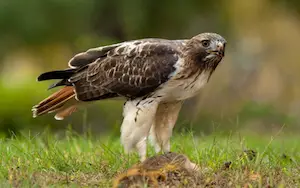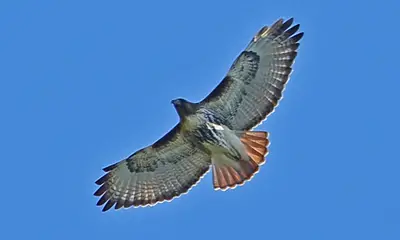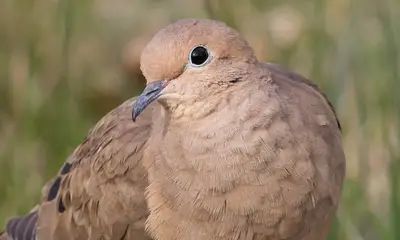SOUNDS Of 17 Types Of NIGHT BIRDS (Guide With Photos & Calls)
Did you recently hear the sound of a night bird, and want to know what species it was?
Identifying nocturnal birds by their sound is not as easy as it might seem, as there are many night birds in North America.
And since it’s hard to get a good look at these birds in the dark, all you have to go on is the noise they make.
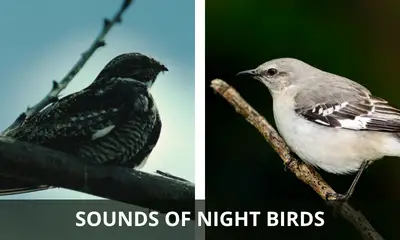
To help you identify the bird you heard, we’ll cover the most common night bird sounds of North America in this article.
What night bird sounds can be heard in North America?
Below are the nighttime sounds and calls of 17 types of nocturnal birds in North America, which fall into four main categories: songbirds, nightjars, herons, and owls.
Songbirds
Northern Mockingbird
Scientific name: Mimus polyglottos
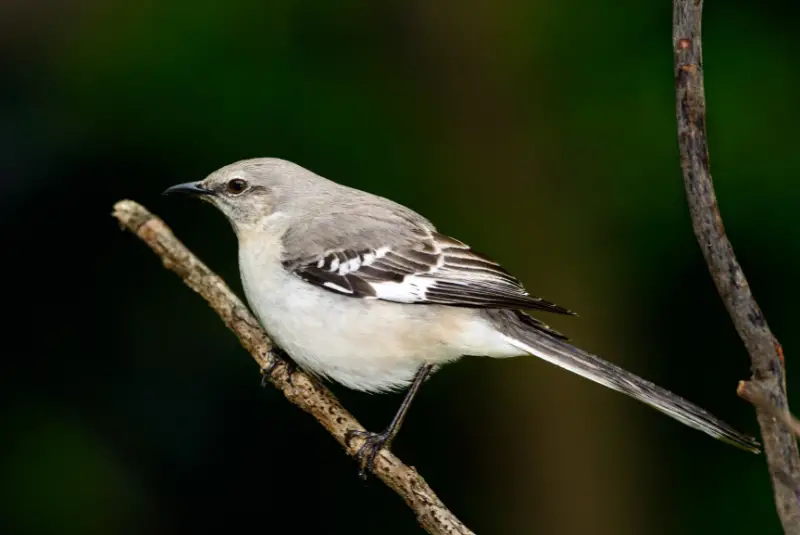
Sound of Northern Mockingbird:
(Recording source: Sue Riffe, XC664292, www.xeno-canto.org/664292)
The melodious whistling song of the Northern Mockingbird can be heard on moonlit nights in many parts of North America.
And while the Northern Mockingbird is also active during the day, young males sing most actively during the night between midnight and 4 AM.
The Northern Mockingbird is a common backyard bird and year-round resident throughout the United States and southern Canada.
If you have one of these songsters in your neighborhood, you’ll hear them every night.
This bird is the only mockingbird species found in North America. It prefers wooded areas as well as urban habitats with sufficient tree growth, such as parks and golf courses.
Yellow-breasted Chat
Scientific name: Icteria virens

Sound of Yellow-breasted Chat:
(Recording source: Richard E. Webster, XC766370, www.xeno-canto.org/766370)
The Yellow-breasted Chat is another songbird that makes noise at night. Similar to Northern Mockingbirds, these birds chirp at night in order to attract mates.
Yellow-breasted Chats are common summer visitors and breeding birds throughout the United States, where they occur from May through August.
These yellow birds are between the size of a sparrow and a robin. They have an olive-green back and a bright yellow breast, a gray face, and a distinct white eyebrow stripe.
They can usually be found in dense areas such as thickets, bramble bushes, shrubs, and along streams.
The diet of this bird consists of small insects, such as moths, beetles, ants, and grasshoppers. They also eat berries such as wild grapes and elderberries.
Nightjars & Nighthawks
Common Nighthawk
Scientific name: Chordeiles minor
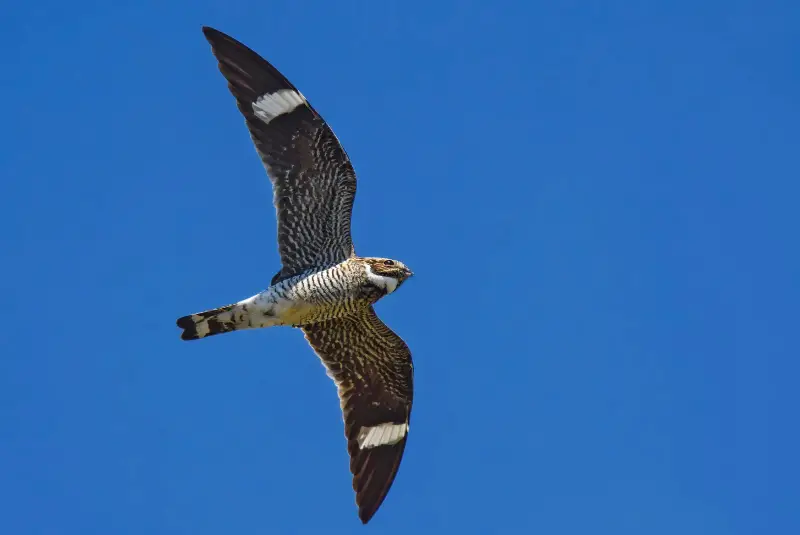
Sound of Common Nighthawk:
(Recording source: Peter Ward and Ken Hall, XC613899, www.xeno-canto.org/613899)
The Common Nighthawk is a member of the nightjar family that is dark brown with white comma-shaped markings on its wings.
The bright white bars on their wings are very conspicuous during flight, and this is a great feature for identifying them.
Nighthawks are most active at dusk and dawn, and if you see one in low light conditions, it looks like a black bird with white stripes on its wing.
During the summer, the Common Nighthawk is a widespread and regular breeding bird throughout North America, but it is a strict migratory species, and spends the winter in South America.
It breeds in a wide variety of open woodland habitats, including urban areas. It feeds on insects that it catches in flight.
Lesser Nighthawk
Scientific name: Chordeiles acutipennis

Sound of Lesser Nighthawk:
(Recording source: Paul Marvin, XC574268, www.xeno-canto.org/574268)
The Lesser Nighthawk is slightly smaller than the previous species, and is also most often observed flying low to the ground around at dusk.
The Lesser Nighthawk is an uncommon summer visitor and breeding bird in the southwestern United States, but is locally common in desert habitats.
These birds hunt swarming insects, and are sometimes found around streetlights that attract flying insects in the dark.
Common Poorwill
Scientific name: Phalaenoptilus nuttallii

Sound of Common Poorwill:
(Recording source: Lance A. M. Benner, XC533392, www.xeno-canto.org/533392)
Similar to other species of nightjars, Common Poorwills are strictly nocturnal and therefore best identified by their two-syllable song.
If you come across one of these birds during the day, it is most likely to be on the ground, where its gray brown camouflage makes it hard to see.
Common Poorwills are summer visitors in large parts of the western United States, but occur year-round in the southwestern parts of the US.
Chuck-will’s-widow
Scientific name: Antrostomus carolinensis
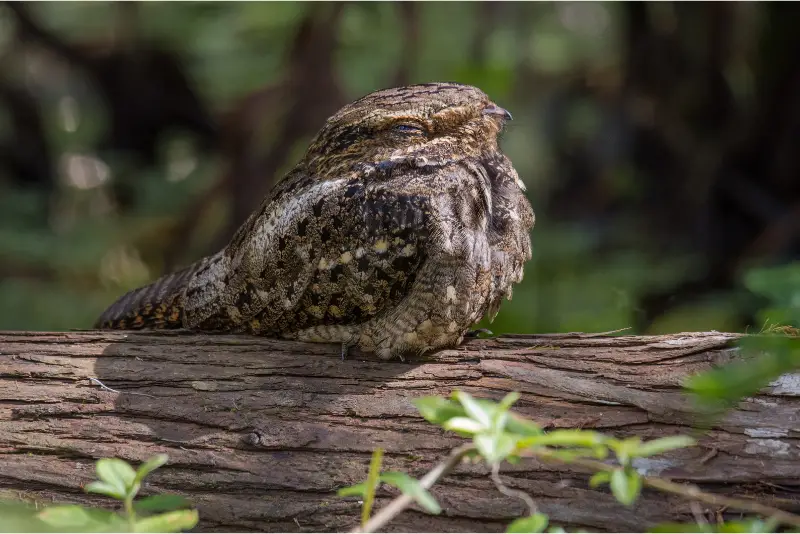
Chuck-will’s-widow call:
(Recording source: Ron Overholtz, XC555492 , www.xeno-canto.org/555492 )
The Chuck-will’s-widow is the largest member of the nightjar family in North America, and is a summer visitor in the southeastern United States.
This bird is most active around dusk and during the night, while it rests on a branch or on the ground during the day.
While it’s difficult to see these well camouflaged birds, the best way to identify them is by their melodious 5-syllable call during the night.
They hunt flying insects, which they catch while flying low over the ground in the dark of the night.
Eastern Whip-poor-will
Scientific name: Antrostomus vociferus
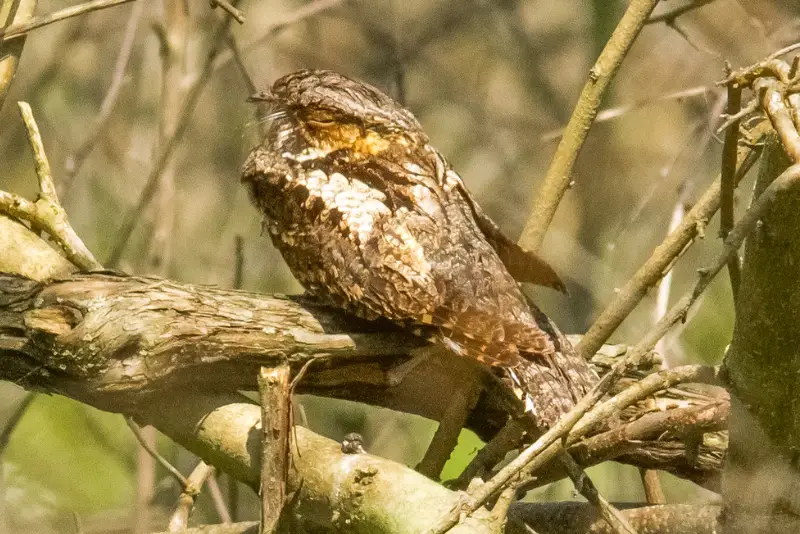
Eastern Whip-poor-will sound:
(Recording source: Paul Driver, XC772248 , www.xeno-canto.org/772248 )
The Eastern Whip-poor-will is another member of the nightjar family.
It is a summer bird breeding in the eastern USA, as well as a scarce winter visitor in coastal areas of southeastern North America from October through April.
Eastern Whip-poor-wills are best identified by their famous 3-syllable nocturnal song, but they are largely silent when wintering in North America.
These nocturnal birds are most active at dawn or at dusk, and this is the best time to spot them as they dart through the air in search of flying insects, or by listening for the strange sound they make.
Mexican Whip-poor-will
Scientific name: Antrostomus arizonae
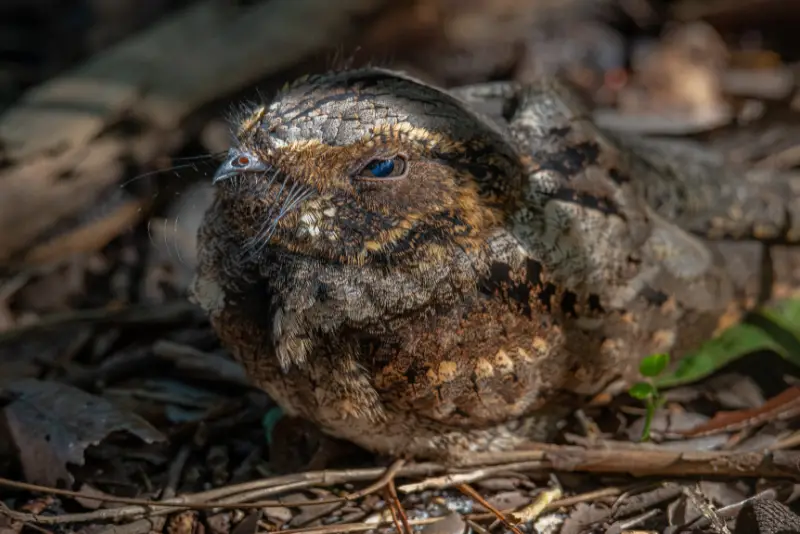
Sound of Mexican Whip-poor-will:
(Recording source: Jarrod Swackhammer, XC253148 , www.xeno-canto.org/253148)
This member of the nightjar species is similar to the Common Poorwill, but has a different song, and is thus best identified by its sound.
These elusive night birds are found in mixed forests of the foothills in the southwestern United States.
They also resemble Eastern Whip-poor-wills, but the two species don’t overlap in range, which makes their identification easier.
Herons
Black-crowned Night-Heron
Scientific name: Nycticorax nycticorax
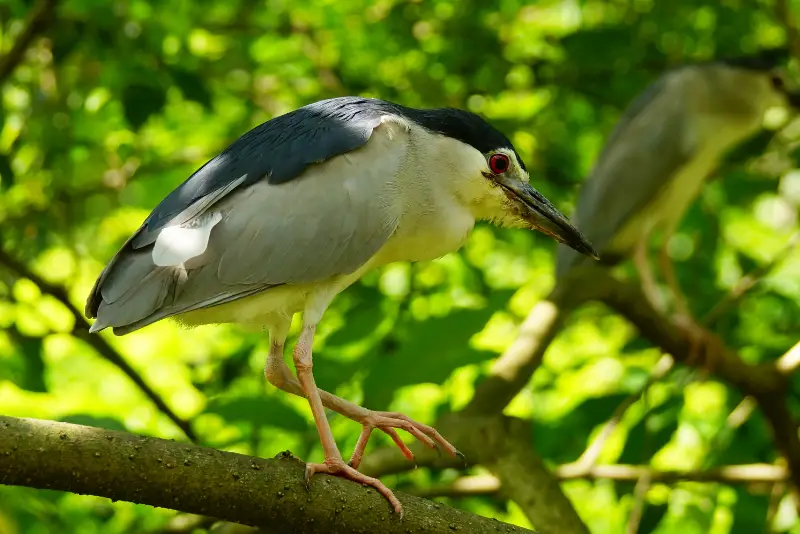
Black-crowned Night Heron sound:
(Recording source: Jens Kirkeby, XC235340 , www.xeno-canto.org/235340 )
The Black-crowned Night-Heron is true to its name, and is most active at dusk and during the hours of darkness, when it forages for frogs and small fish in North America wetlands.
This heron is a common breeding bird throughout large parts of North America, though it can be hard to spot during the day, unless you find its day-time hiding spots.
Another great distinguishing feature of this heron are its strange bird sounds at night, which resemble barking or loud squawking, and which it utters around dusk, when it flies out from its roost.
Black-crowned Night-Herons are social birds, and usually nest in colonies that share the same nesting tree.
Yellow-crowned Night-Heron
Scientific name: Nyctanassa violacea
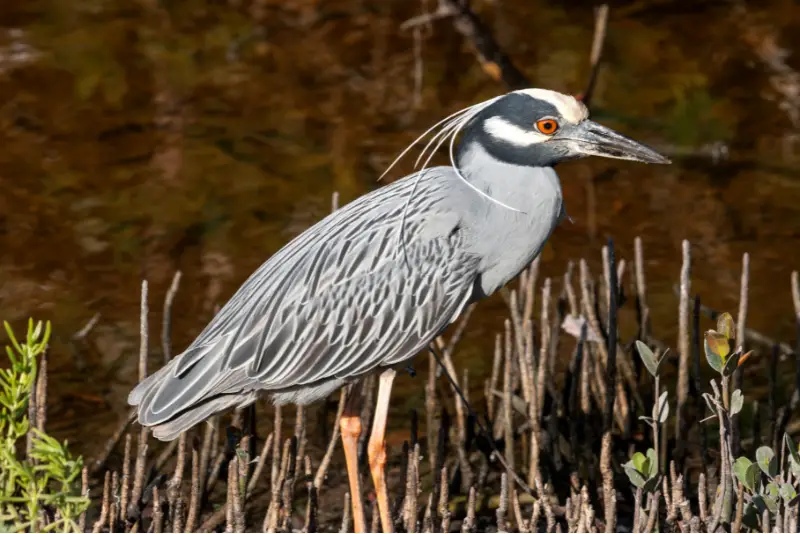
Yellow-crowned Night Heron sound:
(Recording source: Paul Marvin, XC538163 , www.xeno-canto.org/538163 )
The Yellow-crowned Night-Heron is not quite as nocturnal as its Black-crowned relative, and can be seen foraging both during the day and the night.
These herons are most commonly found in coastal habitats, where they forage for crayfish and crabs.
They are summer visitors in the southeastern United States, and can be encountered from April through October.
Owls
Great Horned Owl
Scientific name: Bubo virginianus

Great Horned Owl call:
(Recording source: Christopher McPherson, XC691461, www.xeno-canto.org/691461)
With a wingspan up to 4 feet, the Great Horned Owl is the largest owl species breeding in the United States.
It is a large brown-colored bird with two ear tufts (also called horns) and big yellow eyes. This owl starts its nesting very early in the year, laying its eggs in January or February.
The Great Horned Owl is almost entirely nocturnal, and can hunt in complete darkness by relying on its keen sense of hearing.
It doesn’t build its own nest, but instead occupies the nests of other large birds in North America, such as herons or raptors.
It is found year-round throughout North America, and can be found in a wide variety of habitats, from remote woodlands to urban areas.
This owl is a fierce hunter, catching birds up to the size of ducks, and mammals up to the size of squirrels, rabbits, and even young foxes.
Barn Owl
Scientific name: Tyto alba
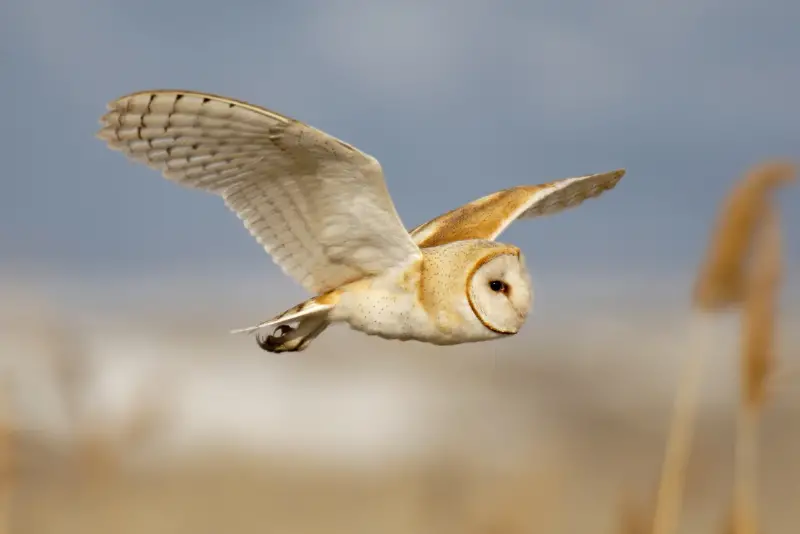
Barn Owl sound:
(Recording source: Jayrson De Oliveira, XC619814, www.xeno-canto.org/619814)
Somewhat softer and less intense-looking than the Great Horned Owl, Barn Owls are characterized by their white coat of feathers, and their “friendlier” appearance.
Armed with exceptional night vision, Barn Owls are strictly nocturnal raptors and therefore hard to spot. However, they can be readily identified by their characteristic screeching calls.
And if you do spot one flying overhead by the light of the moon, you may be able to see the glow of their white underside.
These owls are present in North America all year round, and favor open areas and farmland as their hunting grounds.
Burrowing Owl
Scientific name: Athene cunicularia
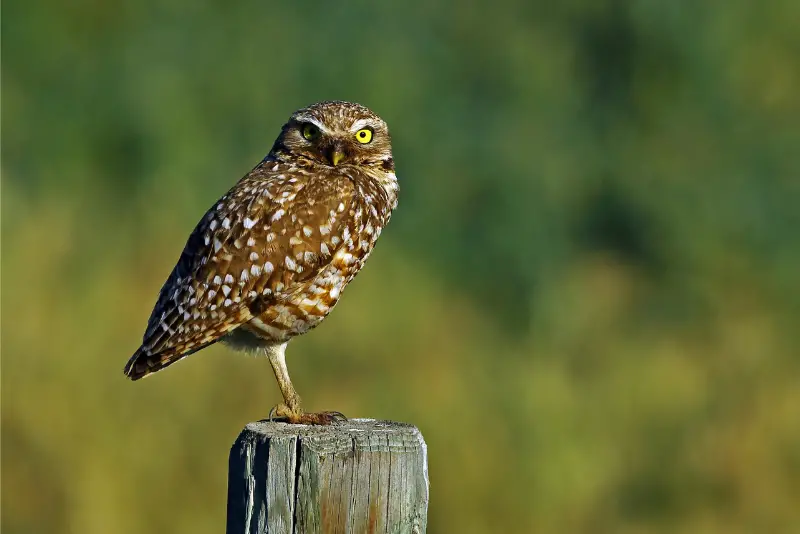
Burrowing Owl sound:
(Recording source: David Ricardo Rodriquez-Villamil, XC524489, www.xeno-canto.org/524489)
The sound recording above is of the territorial song of a Burrowing Owl.
The Burrowing Owl is a scarce resident of open areas in the western United States. It digs its own burrows, but also often takes over burrows from prairie dogs or ground squirrels.
This owl is active both day and night, and hunts insects and small rodents in open areas.
Due to their small size, these owls can be hard to spot in the expanse of open prairies.
They are most often observed perching on a small mound, from where they can scan their surroundings in search of food.
Barred Owl
Scientific name: Strix varia
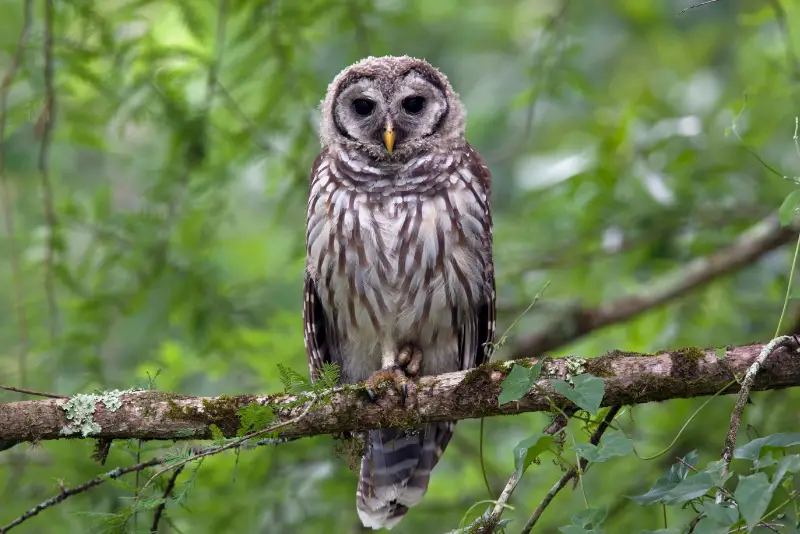
Barred Owl sound:
(Recording source: Jim Berry, XC713081, www.xeno-canto.org/713081)
The Barred Owl was originally a bird of eastern North America, but it has steadily expanded its range westwards over the past century.
Similar to other owls, Barred Owls are easiest to find by listening for their characteristic hooting call at night.
Their preferred habitat is mature forests bordering swamps. They readily accept nest boxes that are set up in old trees.
Long-eared Owl
Scientific name: Asio otus
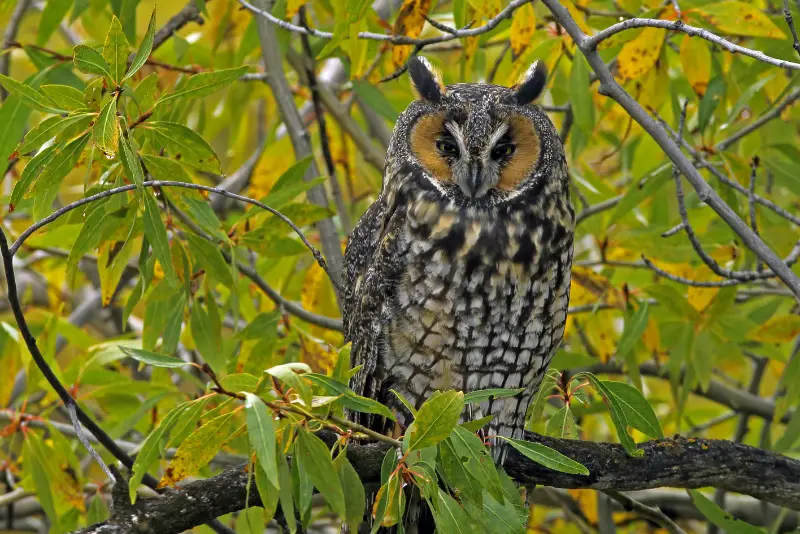
Long-eared Owl sound:
(Recording source: Baltasar Pinheiro, XC737794, www.xeno-canto.org/737794)
These well-camouflaged, elusive owls are smaller than the aforementioned species, and are breeding birds in the northern parts of North America, but also occur further south during winter.
They use their favored habitat of dense wooded areas to prey on the small rodents and animals that call the nearby grasslands their home.
Similar to other owl species, Long-eared Owls can fly completely silently due to fringes on their flight feathers.
Together with their keen sense of hearing, this enables these owls to catch prey by surprising it in the dark of the night.
But despite their best efforts to remain hidden, these owls can be identified by their long, low hoots.
Another great characteristic for identifying these owls is by their elongated tufts of feathers on the ears, and their droppings found underneath conifer trees close to grassy areas.
Short-eared Owl
Scientific name: Asio flammeus

Short-eared Owl call:
(Recording source: Lars Edenius, XC718743, www.xeno-canto.org/718743)
The Short-eared Owl is a highly migratory owl species, and while it doesn’t breed in most parts of the United States, it is regularly observed throughout the United States outside of the breeding season.
Short-eared Owls are more often observed hunting in daylight than other owls species.
Together with their hunting tactic of flying low over the ground in open areas, this makes these owls relatively easy to spot.
You can encounter these owls in any kind of open landscapes, including farmland, airports, and fallow land.
Eastern Screech-Owl
Scientific name: Megascops kennicottii
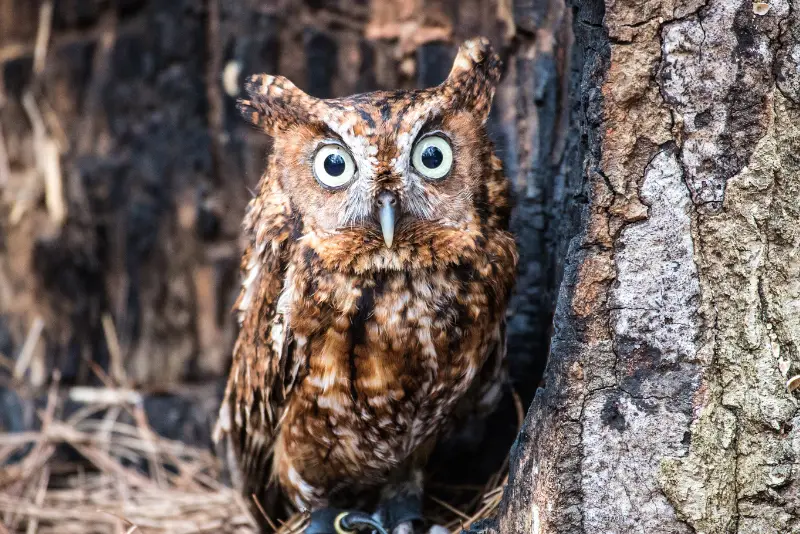
Eastern Screech Owl sound:
(Recording source: Wisconagus, XC690687, www.xeno-canto.org/690687)
Originally birds of open woodlands, Eastern Screech-Owls have adapted very well to urban habitats, and are regularly found in parks, large gardens, and golf courses.
They breed in tree cavities, and are best identified by their characteristic series of accelerating hoots.
These owls are common throughout the eastern half of the United States, and can be seen all year round.
They have a very varied diet, which includes any type of small animal ranging from worms to insects and rodents.
Eastern Screech-Owls readily accept artificial nesting cavities, which means you can attract them to your backyard by setting up nest boxes.
Western Screech-Owl
Scientific name: Megascops kennicottii
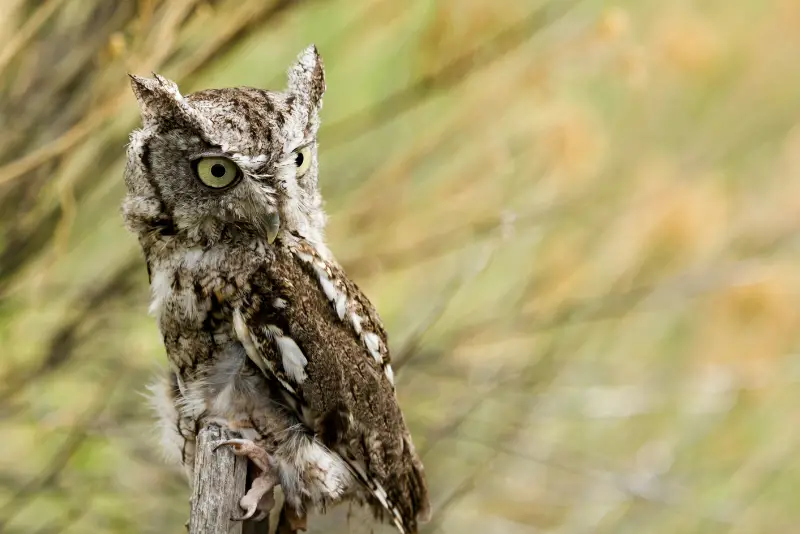
Western Screech Owl sound:
(Recording source: Lance A. M. Benner, XC540561, www.xeno-canto.org/540561)
The sound recording above presents the territorial song sung by Western Screech-Owls, nighttime birds that are widespread throughout western regions within the US and active all year long.
These versatile owls have managed to adapt well to urban spaces such as parks and backyard gardens.
Identifying Western Screech-Owls requires listening for their distinctively accelerating series of hoots. They nest within tree cavities and consume a diverse diet ranging from worms to insects and rodents.
And fortunately for those who wish to observe them in their own backyard – these owls like to accept artificial nest boxes.
What birds sing at night?
The birds that sing at night throughout North America are most often Northern Mockingbirds.
Mockingbirds singing at night are usually young male birds trying to attract a mate. They sing at night most of the year, except during the fall.
In addition to mockingbirds, other common birds that sing at night are nightjars and owls.
Finally, Yellow-breasted Chats also sing at night, and these birds are common summer visitors throughout large parts of North America.
Other birds that occasionally chirp at night are the American Robin, Western Meadowlark, and Killdeer.
It is thought that some of these birds chirping at night have developed their behavior to avoid the noise of cars and other human sounds that are prevalent during the day in urban areas.
Conclusion
In summary, here are the sounds of 17 nocturnal birds in North America:
- Northern Mockingbird
- Yellow-breasted Chat
- Common Nighthawk
- Lesser Nighthawk
- Common Poorwill
- Chuck-will’s-widow
- Eastern Whip-poor-will
- Mexican Whip-poor-will
- Black-crowned Night-heron
- Yellow-crowned Night-Heron
- Great Horned Owl
- Barn Owl
- Burrowing Owl
- Barred Owl
- Long-eared Owl
- Short-eared Owl
- Eastern Screech-Owl
- Western Screech-Owl
While this is a diverse list of bird species (including nightjars, songbirds, owls, and herons), they all have in common that they are entirely or partially active at night.
Many of these night active birds can be encountered all year round in their range, but a number of them only occur in the state only during the breeding season in summer, or as winter visitors.
The varied habitats of North America are home to more than 900 different species of birds, and nighttime birds make up a significant proportion of this rich avifauna.
Ranging from whippoorwills to nighthawks and owls, these night birds play a vital role in the ecology of their habitats.
If you enjoyed this article, check out our guide to the nocturnal birds of California.

